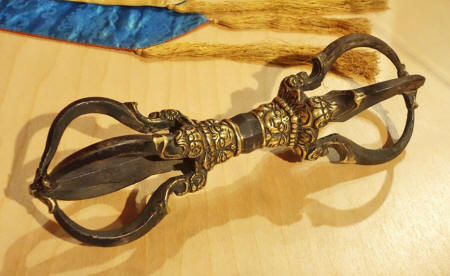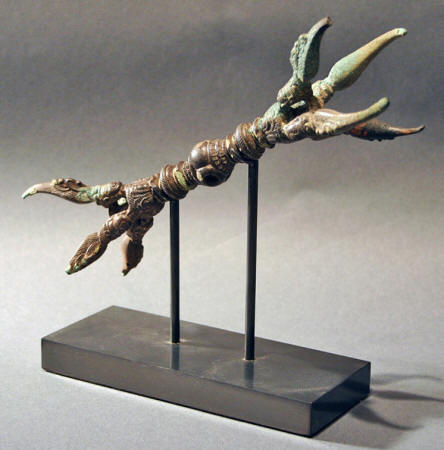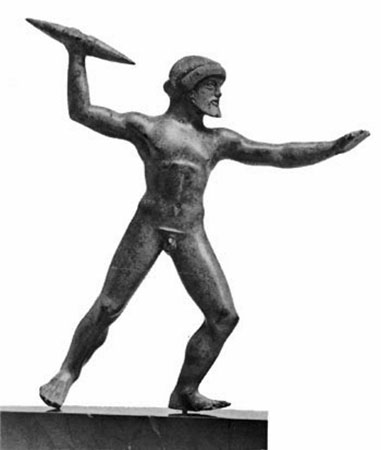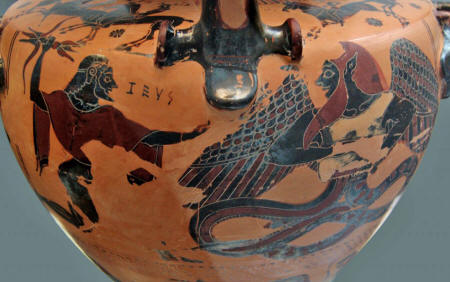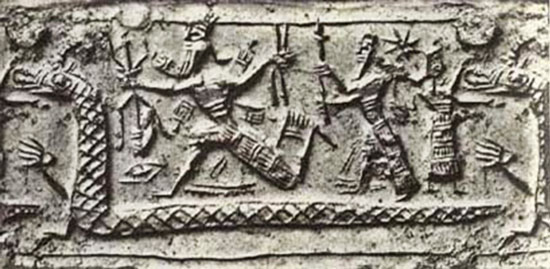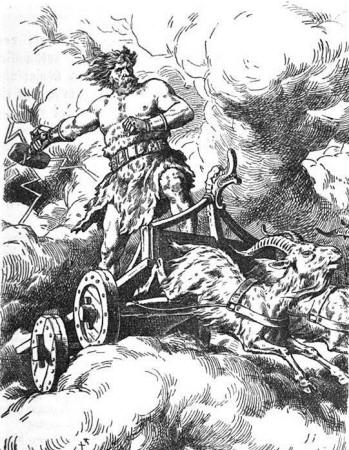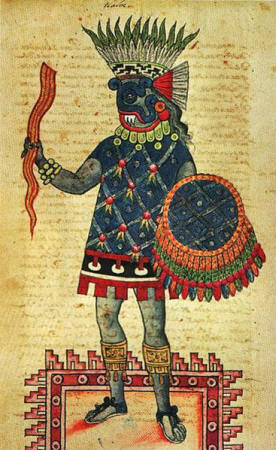|
|
|
May 19, 2015 from SoulHealer Website
Vajra - Weapon of Indra
blazed like a meteoric fireball across the heavens,
in a maelstrom of thunder, fire
and lightning."
The vajra is the most important ritual implement of Vajrayana Buddhism.
In Sanskrit, the word vajra is defined as something
hard or mighty, as in a diamond. It symbolizes an impenetrable,
immovable and indestructible state of knowledge and enlightenment.
According the
Hindu Puranas, the evil Asuras, Namuchi
and Vritra removed all of the light and moisture from the earth. It
made the land inhospitable to living beings. Indra battled the demon
gods unsuccessfully and as a last resort called upon their supreme
god Vishnu for help.
Vishnu had the divine carpenter Tvashta fashion Indra a marvelous weapon he could use to vanquish the dreadful Asuras. This new weapon, the vajra, emitted thunderbolts.
With it, Indra annihilated Namuchi and Vritra and returned the much needed light and moisture back to the earth.
The Rigveda describes this conflict thus.
The vajra, when used, was thrown at ones opponent.
Nitin Kumar, in his article Ritual Implements in Tibetan Buddhism, tells us,
Buddhist legend suggests that Shakyamuni, the Buddah
himself, took the vajra from Indra and forced its prongs closed,
thus transforming it from a destructive weapon into a peaceful
scepter.
They believe that each civilization conceived of their gods independently and that a deeper, older, universal tradition does not exist. If this were the case, then the foundation of these societies; their myths, traditions, beliefs and iconography should be unique to them, their location and their history.
The tales of war, intrigue and conquest that come out of American history are vastly different from those of England, France, India and China.
So too are the customs, traditions and the symbols that represent the nation. Yet when we look at a wide range of ancient and indigenous groups a pattern of commonality exists. Myths and symbols found in Indian readily appear in the oral and written descriptions of other cultures. They also appear in their artistic images.
These representations seem to transcend time and location.
With it, he defeated the Titans and took control of the Greek pantheon. Myth tells us, that Zeus freed the Cyclopes, the master builders, who were imprisoned in the depths of the underworld - Tartarus.
In gratitude for their release, they gave him a marvelous weapon, the thunderbolt. In another story, Zeus used his formidable weapon to battle the largest and most fearsome creatures in all of Greek mythology, the hundred-headed serpent Typhon.
Early images of Zeus depict show him holding a rod
like thunderbolt while others show this deadly weapon with its ends
splayed into three prongs.
The evil and powerful Tiamat, according to the Enuma Elish, was devising treacherous plans against Ea and the other reigning gods.
The gods were afraid to invoke her evil wrath and search for a solution. Ea attempts to confront Tiamat, but instead of fighting backs down. Marduk, his son, steps forward and volunteers to fight the enraged serpent, on one condition…
If he is
successful, he will have dominion over the entire universe.
The gods agree and provide Marduk mighty weapons including a bow, a mace and a net to use in his battle against Tiamat. Images of this epic scene show Marduk holding a three tipped scepter in his hand.
Subsequent images clearly depict this same deadly three-pronged weapon.
Some texts represent it as a notched metal club with thousands of prongs. We find this form of the vajra in numerous other cultures. The most well known stories that portray the vajra in its club-like form come from Norse cosmology.
They are associated
with the sky god Thor.
Thor's mighty hammer Mjölnir was the most fearsome weapon in Norse mythology.
Images of the thunder god Thor traditionally show him carrying his mighty hammer. Some texts describe Mjölnir as a hammer, while others refer to it as an ax or club. The master builders, the dwarfs, in the depths of the earth, made Mjölnir.
The Norse Skáldskaparmál, which can be found in the Snorri's Edda describes Mjölnir as a hammer which would not fail.
As a weapon, it could level mountains. It goes on to
state that if aimed it at anything; it would never miss its target.
It informs us that in addition to never missing its target, it would
always find its way back to the hand of its owner.
Perun, using lightning bolts, would vanquish Veles back to his underground realm annually. His deadly axe, like Thor's mighty hammer was used to subdue evil and overcome the iniquitous serpent Veles.
It too would return to his hand after being thrown.
The Gae Bolga is described as a dart or spear, which separates into multiple barbs when entering the body, causing fatal wounds. It was next to impossible to withdraw once it had impaled the body.
The Irish Book of Leinster describes the devastating effects of the Gae Bolga as such:
In China, the legend of Hua-hu Tiao Devours Yang Chien describes a magical spike carried by Huang T'ien Hua which sounds remarkably similar to Indra's vajra.
Finding myths, with similar storylines, and their corresponding images in relatively close geographic areas, while interesting, does not fully support the universality of the gods.
When we uncover similar narratives and corresponding imagery, in remote regions of the world, this concept takes on a more serious tone. Myths of a vajra-like weapon are found all over the world.
In Australia, the sky gods, the Wati Kutjara brothers, wield a magical boomerang, Wo-mur-rang or club. Boomerangs are known for their ability, once thrown, to return to their owner. Legend states that their father Kidili attempted to rape some of the first women.
Throwing their wo-mur-rang, they castrated their
father where he disappeared into a water hole.
In the new world we encounter a similar deadly lightning weapon used by the sky gods.
A variation of the lightning motif is the concept of the thunderstone.
It is believed that thunderstones fall from the sky when the gods are battling each other. This idea is widely held throughout Africa.
The Yoruba of southwestern Nigeria, for example,
believe their axe carrying storm god Shange creates thunder and
lightning and casts "thunderstones" down to earth. The elders of
this culture would search wherever lightning struck for these
magical stones.
Similarities exist throughout Greek, Sumerian, Norse, Aztec and Australian and American cosmology. These parallels include the gods, their lives and their amazing weapons.
They also include
the laws and customs that govern our lives - the very fabric of
society.
Someone somewhere in our remote past saw it and
documented it. It is only through an actual encounter with a
marvelous weapon that emitted thunder that a clear and specific
portrayal of it could be made.
It would challenge the basis of our society and could
cause us to reevaluate not only our place in the universe, but
everything we hold to be 'true.'
|


